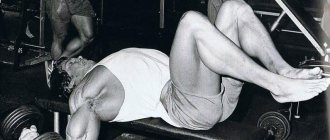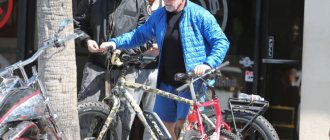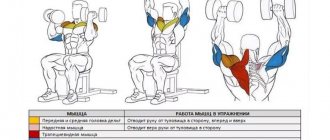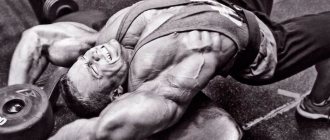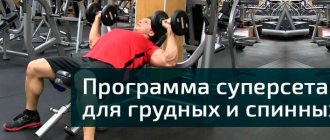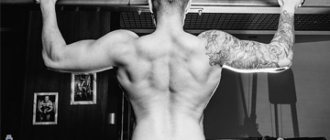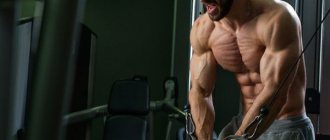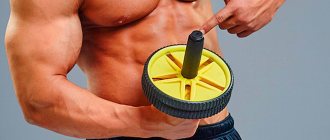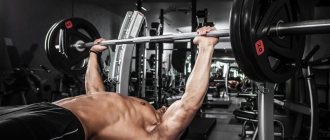Training programsWeight programs
Arnold's philosophy in terms of pumping up the chest and back muscles can be described by the principle of “pairing.” And it worked.
Author:
Sean Perine
Behind his public successes (and failures), loud speeches and campaigns, fame and fortune, it is very easy to lose sight of the fact that at his core, Arnold Schwarzenegger is, first and foremost, a man obsessed with bodybuilding.
Long before he became famous, and long before his battles with state legislators, the five-time Mr. Universe and seven-time Mr. Olympia spent countless hours in small gyms around the country, pushing, squeezing and moving iron. The goal of his efforts was to become the best bodybuilder in the world. And in 1960-70. he achieved this goal by winning one competition after another.
During his school years, Arnold devoted himself entirely to his studies. Later, he worked with the same diligence in the gym, and many years later - on the set and in the governor’s chair. Equally important, he had no fear in the training (another famous Schwarzenegger quality). While his gym mates were conservative in the bodybuilding world for decades, Arnold was always looking for ways to increase intensity.
In the early and mid-60s, at the dawn of his professional career, the future champion trained according to a regular program compiled for him by more experienced comrades from a gym in Austria (his first gym). It was a basic and fairly well-thought-out program, but not so effective as to turn a provincial Austrian guy into a world-class star. When the student's achievements began to surpass those of his mentors, Arnold began to realize that without finding new ways to increase the intensity of training, he risked ending his career as the owner of the title "Mr. Europe." Arnold began studying Muscle Builder magazine (now called Muscle & Fitness) in search of solutions to “shake up” his training and eventually came across the “Weider Principles” - a set of methodological techniques for increasing the intensity of training.
By the end of the 60s, he developed his own formula, which consisted of six training days a week, two workouts a day, and included a number of Weider principles, incl. his favorite is supersets.
Ready... attention... superset!
“One of the main explanations for the effectiveness of the chest-back program is that almost all chest exercises are pushing exercises, and back exercises are pulling exercises. In rows that load the lats, the chest rests, and vice versa - the lats rest in chest exercises. This alternation of rest and exercise ensures a constant flow of blood to the muscles... When working on the chest and back at the same time, there is an incredible feeling of muscle growth and an increase in their volume” (Arnold Schwarzenegger).
Using supersets involves grouping two or more exercises, which are performed without interruption. There are two types of supersets: when exercises are grouped on one part of the body and when exercises on different parts of the body are combined. Arnold liked both options. He especially often used supersets to train the chest muscles.
“There are several advantages of alternating the load on the chest and back muscles,” Arnold said more than once:
- Time saving; training goes much faster.
- Ability to lift heavier weights to gain mass and develop strength.
- Pumping effect and high-quality pumping of muscles (both chest and back) for their complex load; the muscles are filled with blood for a longer time.
- High muscle density due to working with extreme weights.
In his seminal work, The Encyclopedia of Modern Bodybuilding, Arnold explains in detail the benefits of using chest-back supersets.
Anatomy of the back muscles
To know which exercises are best for the back and how to properly train this part of the body, it is recommended that you familiarize yourself with how it works, that is, study in general terms the anatomy of the back. In general, back muscle tissue is present throughout the upper back surface of the human body. Muscles can be divided into:
- superficial , which have two layers. These are the so-called latissimus and trapezius muscle elements, and the second layer is represented by the serratus and rhomboids, as well as the muscle that is capable of lifting the scapula;
- deep.
Back muscles
Resistance bands and wrist trainers
Table. Muscles of the back area.
| Name | Characteristic |
| Latissimus | This is a thin muscle, triangular in shape, but quite large in area. It is immediately visible if you look at the athlete’s back. Its main functions are the ability to extend the shoulder and bring the arm in line with the rest of the body. She is also able to pull the body towards the arms when performing a set of exercises on the horizontal bar. Used by the body during swimming and climbing. |
| Trapezoidal | Also triangular, like the previous one, but the base of the muscle “triangle” is located along the midline at the back. Partially extends to the neck area, located in the upper back area. Flat. Allows you to pull the scapula towards the spinal column. |
| Levator scapula | This muscular element originates in the area of the cervical vertebrae, it is attached to them with the help of tendons and spreads down the back, eventually attaching to the shoulder blade. When moving, he is able to lift the scapula, bringing it closer to the spinal column. |
| Diamond-shaped | Represented by the major and minor muscles. Usually these elements grow together into a single system. They originate in the area of the thoracic and cervical vertebrae and are fixed on the shoulder blade. The functions are the same as the previous muscle. |
| Serrated | These muscles are capable of moving the ribs, raising and lowering them. They occupy most of the entire muscular corset of the back. They have three layers - deep, middle, superficial. The surface layer is capable of straightening the spine. The muscles run along the back along the entire spinal column. In addition to it, they help keep a person in an upright position. Other parts of the serratus muscles are located on both sides of the spine, and can be seen especially clearly in the lumbar region. They create a small depression between themselves. Helps to bend and straighten the back. |
On a note! Also, all back muscles can be divided into three zones - the muscles of the lower back, trapezius and latissimus. The appearance of the back will largely depend on how pumped they are.
Training program
Few bodybuilders use double splits these days. It has been argued that a program with two workouts per day is too taxing on the body. Apparently, this technique did not harm Arnold at all. In the 1970s, double splits were considered normal for most professional athletes training at Gold's Gym in Venice, California.
| Morning | Evening |
| 1. Chest, back | Hips, calves, abs |
| 2. Shoulders, arms | Calves, abs |
| 3. Chest, back | Hips, calves, abs |
| 4. Shoulders, arms | Calves, abs |
| 5. Chest, back | Hips, calves, abs |
| 6. Shoulders, arms | Calves, abs |
| 7. Rest | Rest |
Arnold's chest/back workout consists of nine exercises: four for the chest and four for the back, plus a dumbbell pullover (a compound exercise that targets the lats and targets the pecs). In total it includes 45 approaches. There are no breaks between sets in a superset (you should rest for one minute or a little more between supersets). At the end of the workout, it is necessary to perform intensive stretching of the muscles that were loaded.
The duration of the workout is about 45 minutes. During this time, Austrian Oak was so exhausted that he could barely breathe, and the sweat poured from him like a stream. They say that in the Gold's Gym there was a special oxygen cylinder, with the help of which Arnold and his partners recovered from such difficult training.
Obviously, all these efforts were not in vain; When measuring Arnold's chest, the tape measure stretched to an incredible 145 cm. His pectoral muscles looked impressive. His back is still considered a model in the world of bodybuilding.
Perhaps using Arnold's chest-back training program will not turn the average gym goer into an epic hero. However, this tough, effective technique is sure to result in increased muscle mass in your upper body.
The best strength exercises for pumping
Experienced athletes consider the six exercises described below to be the best for working the back. The first is the barbell row to the belt. It is basic and allows you to gain muscle mass. When performing deadlifts, you need to tilt your body at an angle of 45 degrees relative to the floor, keep your back straight, tensing your abs. The knees need to be slightly bent. Elbows in the top position of the arms are raised as high as possible.
Barbell row to the waist
Simple pull-ups with your arms placed narrowly on the bar are very helpful in pumping up your back. They will also provide stress on the arm muscles. To warm up your back muscles and prepare them for training, you can perform several so-called reverse flyes on the block. The main thing is to perform them slowly and with moderate load. The shoulder blades should be brought together as close as possible during the exercise. The muscles are also worked well when stepping with a barbell.
Reverse dilutions on the block
Important! It is important to perform steps with a barbell correctly! Otherwise, you can cause serious harm to your back.
In addition to the barbell, to pump up your back, you can use a fitball, on which you can perform several hyperextensions while lying on your stomach. In this case, the extensor muscles work great. The “flying superman” also gives a good load; it pumps up the lower back perfectly.
"Flying Superman"
Strength training with dumbbells
For those who are not ready to lift a barbell, we can recommend a set of exercises with dumbbells.
Step 1. The first exercise with dumbbells is the deadlift. It can only be performed if there are no back injuries. You need to place your feet shoulder-width apart, with your knees slightly bent. Next, take a dumbbell of a comfortable weight in each hand. They are located on the front of the thigh. Next, the dumbbells are lowered down, while it is important to ensure that the back is straight and there is no overload of the lumbar part. You need to look straight ahead. Next, you need to slowly return to the starting position.
Deadlift
Step 2. The second exercise is one-arm row. The most convenient way to do it is using a gymnastic bench. The left knee should be placed on it, and the hand should rest on it. The back should take a position parallel to the floor. You need to take a dumbbell in your right hand, which is then slowly raised by bending the arm at the elbow to body level. Then the dumbbell slowly lowers down. The exercise will need to be repeated on the right side of the body.
One arm row
Step 3: Bent rows will immediately work the left and right sides of your back. You will need to lie on your stomach on a gymnastic bench, positioning your body at a slight upward angle (from 30 to 45 degrees). You need to take dumbbells in both hands at once, and then lift them, bending your elbows, to body level and slowly lower them.
Lying row
Step 4. Next you need to do several approaches of the overhead pull-down exercise. For this, you will also need a bench, on which this time you need to lie with your back and hold dumbbells (1 or 2) with both hands. Feet should be placed on the floor. The dumbbell is initially located near the chest, and then slowly transferred behind the head until tension appears in the arm muscles. Elbows bent. Then the hands return to their original position.
Pull behind the head
Step 5. Raising your arms back will help pump up your upper back. It can be done while sitting on the edge of a bench. The body leans forward, the dumbbells are held in the hands and placed near the floor or under the knees. You need to bend your elbows slightly and you can slowly lift the dumbbells so that the trajectory of their movement resembles an arch. As a result, your arms should be fully straightened.
Bench press on a horizontal bench + Pull-ups with a wide grip behind the head
The first superset in the training program begins with a warm-up of 30-45 reps on the bench press with a weight of 60 kg, followed by 15 pull-ups. For the next five sets, Arnold alternated bench presses and pull-ups, increasing the weights in a pyramid pattern on the press and decreasing the number of repetitions on both exercises. Typically, he followed the following pattern for these two exercises: 15, 15, 12, 8, and 6 reps. It should be noted that Arnold paid close attention to his breathing and tried to breathe deeply in this superset.
Incline Dumbbell Bench Press + Incline T-Bar Row with Both Arms
After resting for two to three minutes before the next superset, Arnold continued his workout. The T-bar row was one of the champion's favorite exercises. It thickens and widens the lat muscles and provides them with a good stretch.
Again, Arnold performed this superset in a pyramid fashion, starting with 15 reps and moving to 12, 12, 10, and 10.
Dumbbell curls lying on a horizontal bench + Bent-over barbell rows with a wide grip
Arnold was a great expert in exercise techniques. This was most obvious in the lying dumbbell exercises.
Guys in gyms doing this exercise lower the dumbbells, usually to chest level, and bring them together at the top of the movement (before impact). Arnold used a completely different technique - he tried to lower his elbows as low as possible so that the dumbbells were approximately at the level of the bench. In the positive phase, he moved his arms strictly in an arc, stopping the movement at the point at which the distance between the dumbbells was about 30 cm (when the tension in the pectoral muscles began to decrease).
For the bent-over barbell row, Arnold stood on a bench or high platform for maximum muscle stretch at the bottom. His torso was almost parallel to the floor. All repetitions were performed with perfect technique. No jerking; the entire load went to the back muscles.
For both exercises, Arnold did pyramid sets of 15, 12, 10, 10, and 10 reps.
Arnold's calf workout
When I first came to America in 1968, I did not have large calf muscles. In 1969 I visited Reg Park at his home in South Africa and stayed with him for a while. Per often woke up at 5 a.m. to train. Since he was my idol during those years, I also had to get up at 5 am. The first thing he started any workout with was 10 sets of calf raises. His calves were huge, about 50 cm in circumference. I remember looking at them and saying, “I want a drumstick like that.” He loaded the machine with 220 kg and began his first approach.
I screamed: “220 kg! I’ll tear off my Achilles tendons!” To this Per answered me: “During normal walking, when one of your legs takes a step, the other one carries 112 kg. respectively, both legs are able to withstand 220 kg. But to really make your calves grow, you need to get to a working weight of 450kg.” I screamed: “It can’t be!” In the first year, my lower leg grew by 5 cm. It grew so quickly that some people began to suspect me of using implants.
They started checking me, looking for signs of scars when I tensed my muscles. I took this kind of attention as a compliment - my calves have increased to 52 cm. The main exercises I use should not surprise you in any way: “donkeys”, standing and sitting calf raises in the machine, as well as in the leg press machine. Each of these exercises in 6 sets of 10-20 repetitions.
But much more important, in addition to the number of repetitions and sets, is the style of exercise. To achieve maximum development in your calves, you need to use the full range of motion on each rep.
This means achieving full stretch at the bottom of the amplitude and maximum contraction at the top. Again, it's all about systematic progress. If you're using a 1,000-pound weight but can't perform the full range of reps, you're just wasting your time. Your goal is to use as much weight as possible while performing the exercise through the full range of motion. In addition, I used all possible techniques in order to develop maximum intensity and stimulate muscle growth.
Besides forced reps with the help of a training partner, my favorite techniques were peak contractions and what I called the “pump action.” The principle of peak contraction is extremely simple and its essence is to hold the weight at the top point of the amplitude for 3-4 seconds before lowering it.
It's always painful, but I was conditioning myself that the pain and burning would make me bigger. The pumping action was used at the end of an approach, for example, seated calf raises or a leg press machine. After I could no longer complete full range reps, I would finish set 6 with a series of reduced range reps (without dropping my heel all the way down or lifting it all the way up) until my calves began to cry out in pain. This technique sculpted the outer shape of my lower leg into truly champion shape.
| Exercise | Approaches | Repetitions |
| Calf raises (“donkey”) | 5 — 6 | 15 — 20 |
| Standing calf raises | 5 — 6 | 10 — 20 |
| Seated calf raises or leg press machines | 4 -5 | 10 — 15 |
Weighted dips + close grip pull-ups
At this stage, Arnold was already beginning to breathe quite intensely. Half an hour of double pumping on the pectoral and back muscles noticeably expanded the upper body. However, you cannot give up.
Arnold hung a dumbbell weighing more than 35 kg from his belt and tried to perform 15 repetitions in each of five sets of push-ups.
For close-grip pull-ups, he typically used a V-shaped handle that he hooked onto a bar. Typically, he used a close, pronated grip and did 12 reps for each of the five sets.
Pullover with straight arms
Although there is still debate about the effectiveness of this exercise in terms of expanding the chest, Arnold had no doubts about this and performed pullovers throughout his professional career.
No matter what anyone says, the pullover is an excellent exercise that not only works the latissimus and hard-to-reach serratus muscles, but also stretches the pectoral muscles well.
Typically, Arnold would lie across the bench to keep his hips as low as possible and provide maximum chest extension.
“You won’t believe how this exercise feels in the chest area!” said Arnold. “It literally rips apart the ribcage and causes it to grow.”
Despite the brutal fatigue, he squeezed himself out, breathing deeply, for five sets of 15-20 repetitions at full amplitude. Only after this the training was completed.
Arnold's leg workout
To add significant value to your legs, you need to shock them - this is the key to success. The most obvious solution is to perform lots of very heavy sets of compound movements: barbell squats, leg presses, and hack squats. Since the legs are a massive muscle group, you will have to train them to a much greater extent than other, smaller muscle groups.
Often, I would do more than 20 sets for the quadriceps alone and only then move on to working the hamstrings. High-volume, high-intensity workouts will shock your legs and make them grow, but adding detail to your legs is just as important.
Why do you need big hips without relief and shape? This is why I used techniques like drop sets during hack squats. I loaded the machine with a weight that would only allow me to do about six reps. Then I would drop the weight a little and do six more. So I would drop the weight and perform the exercise without rest until I had about 30 reps. And this is just one approach! I also used the same technique when doing hip extensions.
But my most significant breakthrough in leg development came in 1971, when I was looking for methods to add more detail to the legs. I started the workout by doing leg extensions followed by barbell squats. This method is now called pre-exhaustion.
When doing kips, I did very heavy sets and went all out on them, instead of using this exercise only as a warm-up and prep for squats. By the time I moved on to squats, my quads were already dead.
| Exercise | Approaches | Repetitions |
| Superset leg extensions with barbell squats | 5 — 6 | 15 — 20 |
| Leg presses | 5 | 15 |
| Squats on a hack machine | 4 | 30 |
Isometric contraction
After finishing his workout, Arnold always stretched and posed for a few minutes. He was of the opinion that after training it was necessary to supply all the muscles with oxygen-rich blood and believed that it was thanks to this technique that his muscles looked more pumped up and sculpted.
Finally, after 45 minutes of hard work and several liters of sweat, Arnold completed his morning workout. “Going into the shower, I felt tired but satisfied - like a heavyweight boxer who spent 15 rounds in the ring with the champion and knocked him out a few seconds before the end of the fight!”
Chest/Back
Superset:
Bench press 5
sets of
15, 15, 12, 8, 6
reps
Wide grip pull-ups 5
sets of
15, 15, 12, 8, 6
reps
Superset:
Bench press with a positive incline 5
sets of
15, 12, 12, 10, 10
reps
Bent-over T-bar row with both hands 5
sets of
15, 12, 12, 10, 10
reps
Superset:
Dumbbell curl while lying down 5
sets of
15, 12, 12, 10, 10
reps
Bent-over barbell row 5
sets of
15, 12, 12, 10, 10
reps
Superset:
Dips - an option for working the pectoral muscles 5
sets of
15
reps
Reverse grip pull-ups 5
sets of
12
reps
Completion:
Straight arm pullover with dumbbells lying on a bench 5
sets of
15
reps
